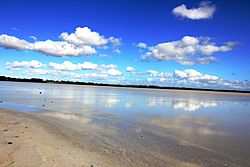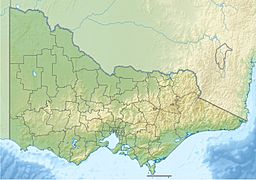Lake Beeac facts for kids
Quick facts for kids Lake Beeac |
|
|---|---|

Shallow water and the crystallizing of salt reflect the sky beautifully on Lake Beeac
|
|
| Location | Western District Lakes, Victoria |
| Coordinates | 38°12′18.5″S 143°36′59.5″E / 38.205139°S 143.616528°E |
| Type | Endorheic, hypersaline |
| Primary outflows | Evaporation |
| Basin countries | Australia |
| Surface area | 560 ha (1,400 acres) |
Lake Beeac is a special kind of lake found in south-west Victoria, in southeastern Australia. It's located right next to the small town of Beeac. This lake is known for being very salty, which is why it's called a hypersaline lake. It's also an endorheic lake, meaning water flows into it but doesn't flow out to rivers or oceans; it only leaves by evaporating.
Lake Beeac covers about 560-hectare (1,400-acre) of land. It's located about 19 kilometres (12 mi) northeast of Colac. Because it's so salty, the water often looks a milky-blue color. This lake is part of the Western District Lakes site, which is listed under the Ramsar Convention. This means it's recognized internationally as an important wetland and helps protect its amazing waterbirds.
Amazing Wildlife at Lake Beeac
Even though Lake Beeac is extremely salty, it's home to tiny creatures called brine shrimp. These shrimp are a super important food source for many different waterbirds. Birds like the banded stilt and the red-necked avocet love to eat these shrimp.
Some birds travel incredibly long distances, even from places like Siberia and China, just to feed on the shrimp in Lake Beeac! This shows how vital the lake is as a habitat for wetland birds. The lake is also part of the Lake Corangamite Complex Important Bird Area. This area is identified by BirdLife International because it sometimes supports a huge number of waterbirds from all over the world.
A Salty History: Making Salt at the Lake
For many years, from the late 1860s until the 1950s, people used Lake Beeac and other nearby lakes to collect salt. This was a big business!
One person, Henry Berry, who was a spice merchant from Melbourne, started a salt works at Lake Cundare, just north of Beeac, in 1868. He made salt by boiling and crystallizing it. His company produced a fine salt for cooking and eating, which they called "Tower of London" salt. However, this production stopped in 1895.
Lake Beeac itself was mainly used for collecting salt that had naturally crystallized during the hot summer months. This process created a coarser type of salt, which was then sold for farming and industrial uses. How much salt they could collect depended a lot on the weather. For example, in the hot, dry summer of 1921, they collected a massive 3,000 tonnes of salt! But if the summer was wet, they couldn't collect any salt at all.
Commercial salt production at Lake Beeac eventually stopped in 1954. By then, it became cheaper to produce salt in other places, making the salt from Lake Beeac too expensive to sell.


